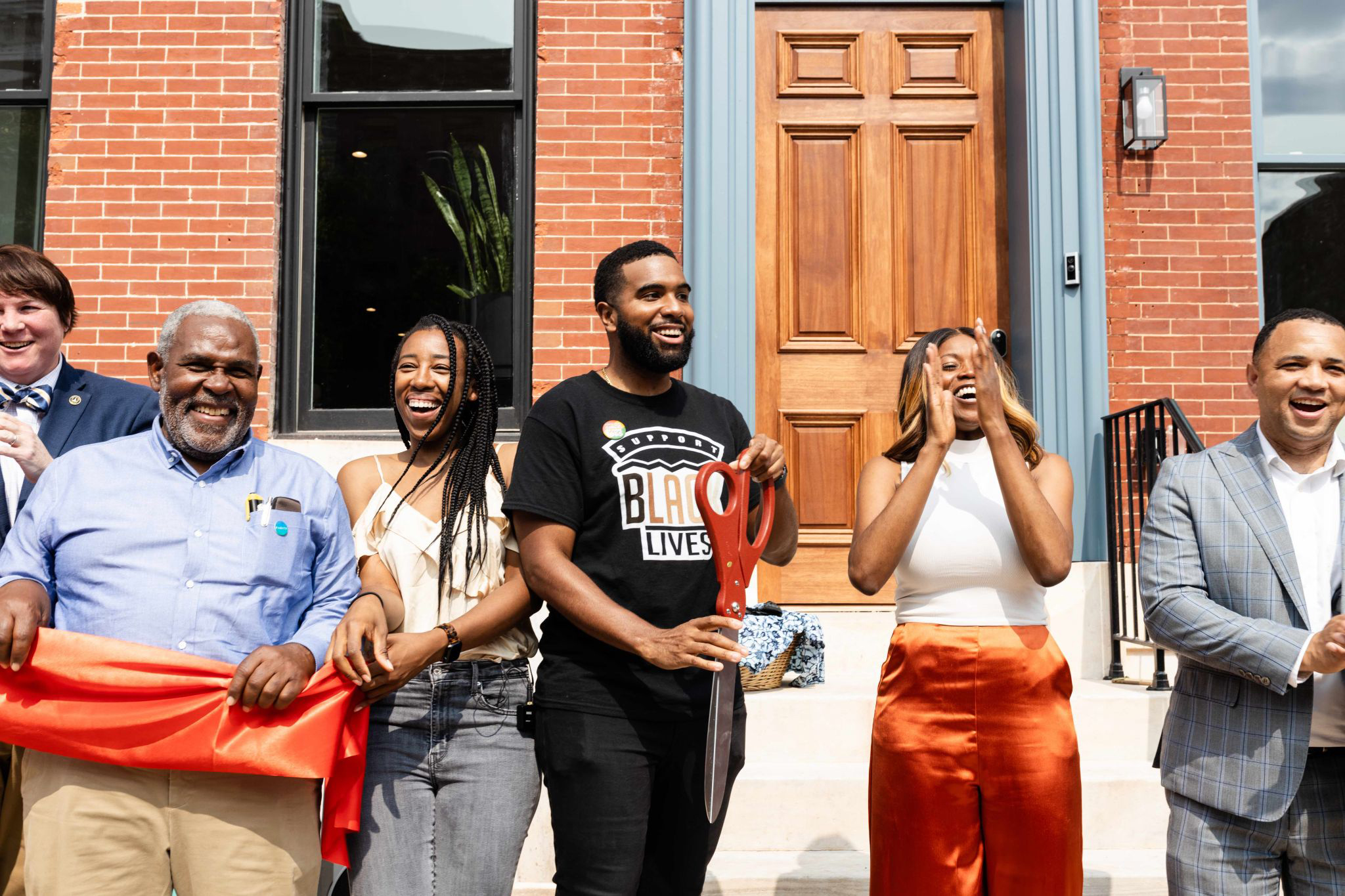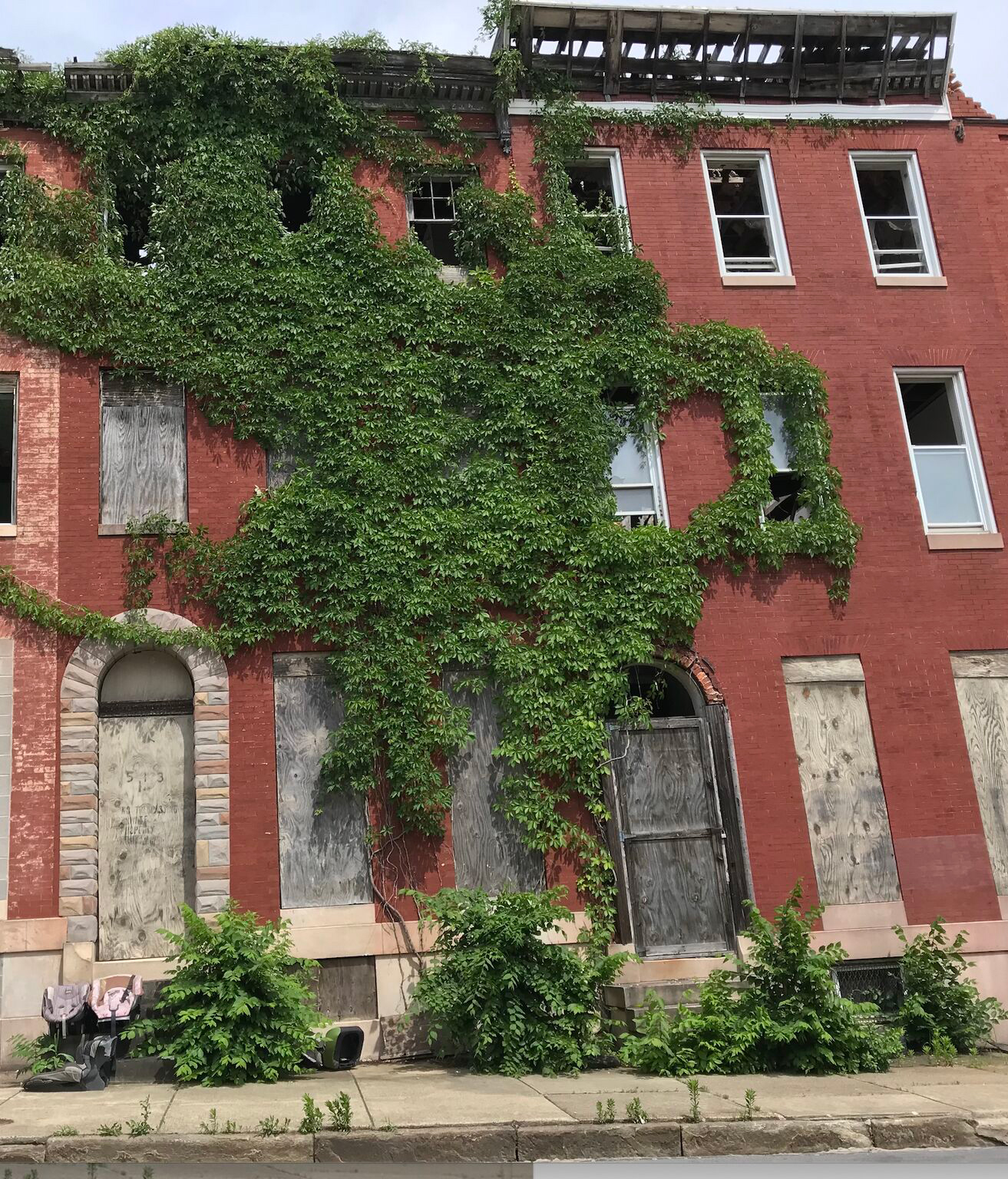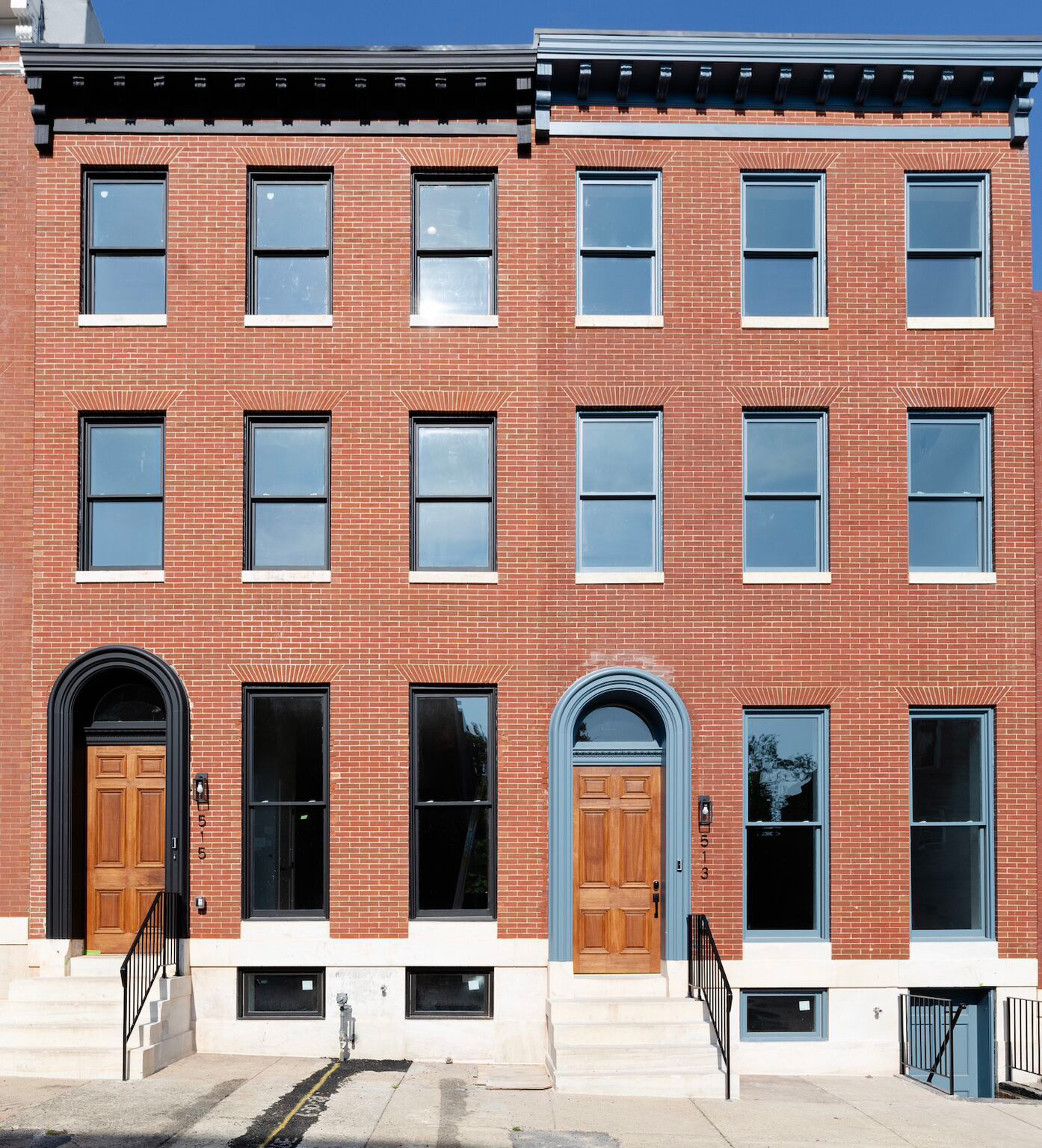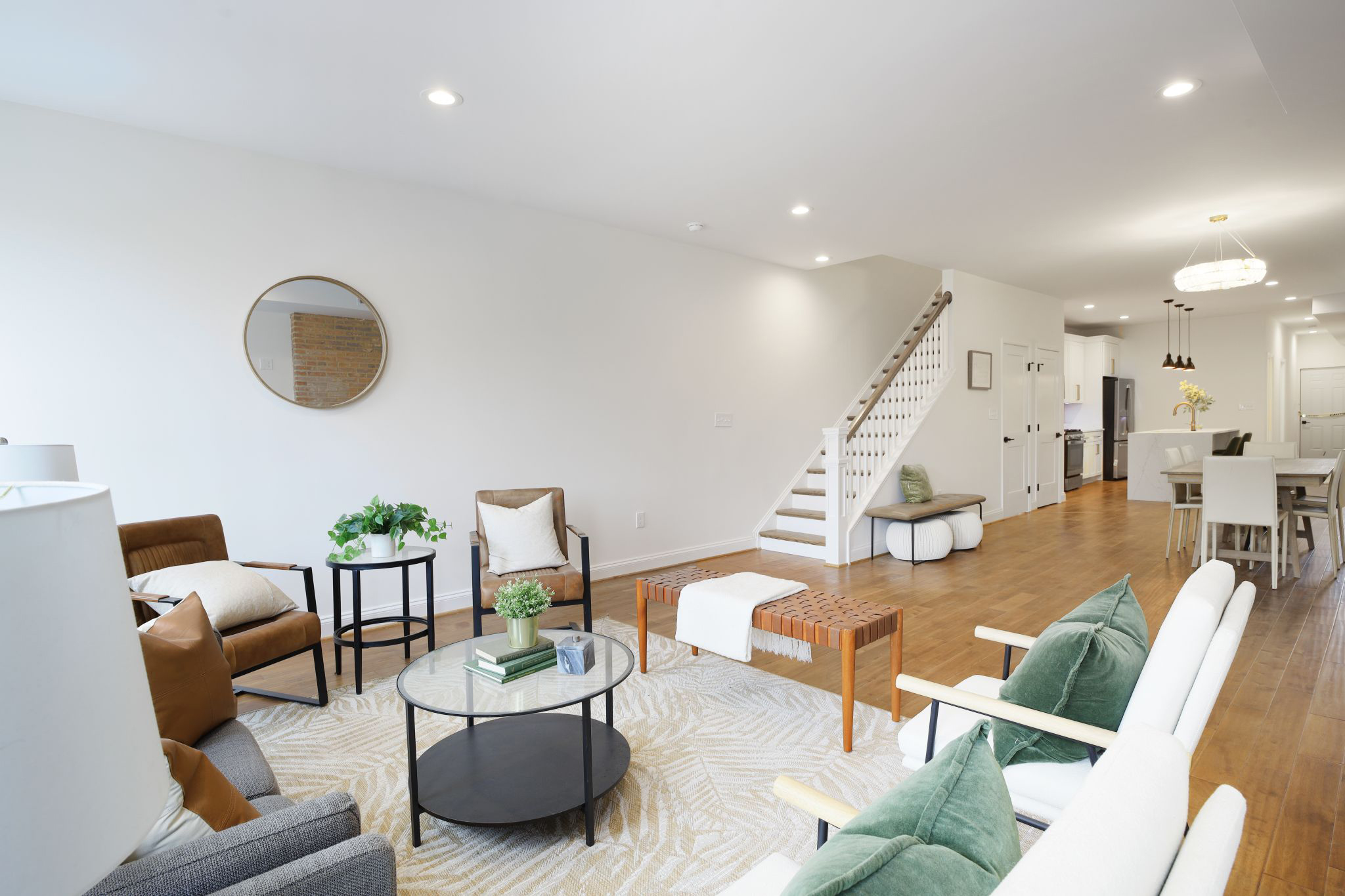Bree Jones
Founder and Chairman, Parity
Fellow project website: www.parityhomes.com
Bree Jones is turning abandoned structures within historically redlined neighborhoods into opportunities for Black homeownership and the revival of once-thriving Black communities.

THE NEW IDEA
Through her organization Parity, Bree turns the growing problem of hyper-vacancy in cities like Baltimore into an opportunity to expand affordable housing – and grow homeownership and wealth among Black Americans. Parity recruits cohorts of aspiring homeowners, helps them access financing, and – with their collective commitment to buy and live in restored homes – rehabilitates entire blocks of abandoned rowhouses in historically significant Black neighborhoods. The cost-effective model creates affordable homeownership opportunities in the most oppressed housing markets, not in spite of high rates of vacancy but, in a sense, because of the legacies of underinvestment and abandonment. Bree is proving that people still value these neighborhoods, and in doing so, she’s prompted a major revaluing of Black neighborhoods by both Black residents and financial instructions. Because it’s not just the bones of a house that give it value, it’s the way in which neighbors and the surrounding community make it a desirable place to live, and now whole groups of new homeowners can benefit from that value they themselves are creating.
Bree flips much of the housing development playbook on its head. While most developers court well-to-do individuals, Bree sees power in groups of aspiring first-time homebuyers. While most developers focus on affordable rentals, she’s focused on homeownership. Where most developers focus on relatively stabilized neighborhoods to reduce risk, Bree goes into the riskiest, most underserved communities. And where most development drives gentrification, Bree’s approach makes sure that legacy residents stay put. She calls it “development without displacement.”

Photo Credit: Bree Jones
To speed up what is a notoriously slow process, Bree has found ways to outmaneuver costly barriers, for example by dramatically reducing the time it takes to wipe tax liens from abandoned homes whose owners have fallen behind on payments. In all this she’s proven that working at her pace and scale makes financial sense for home- buyers, financial institutions, construction companies, and municipalities alike. As such, Parity’s model for leveraging Black homeownership and collective social capital as a foundation for wealth building and social justice has major implications for cities across the country, many of which have reached out to Bree for guidance as they see in her approach a solution to the challenges of affordable housing, hyper vacancy, and the persistent Black-White wealth gap.
"Part of what makes our model distinct from other developers is that we’re not just focused on the construction of new housing, but we’re focused on ensuring that legacy residents are retained and can stay in their neighborhood as long as they want and participate in the revitalization.”
- Bree Jones
THE PROBLEM
Each American city has its own unique set of impediments to the creation of affordable housing. Baltimore, known colloquially as the “birthplace of redlining,” set a national precedent for discriminatory real estate tactics in the early 20th century and today bears the scar of this legacy in the more than 16,000 blighted and abandoned buildings in what is known as the “Black Butterfly” of East and West Baltimore. In two of these neighborhoods (where Parity is currently working) more than a third of households are living below the poverty line; over a third of properties are abandoned; and only a quarter of homes are owned by residents (most of whom are elderly). There are no banks, no grocery stores, and 40% of households don’t have internet access. Moreover, 95% of residents are Black, highlighting Baltimore’s struggle with segregation and concentrated race-based poverty. High levels of vacancy further concentrate poverty and lock communities in a downward economic spiral.
Distressed neighborhoods like these typically follow two trajectories. In the first, the neighborhood is deemed unsavable. Continued disinvestment causes a deterioration of housing stock, which decreases quality of life and pushes people to move elsewhere. This signals to financial institutions that these places are risky and unredeemable. In the second, low-land values attract speculative developers who use predatory tactics to purchase and flip inhabited homes, displacing native residents and till-ing the soil for rapid gentrification. In both instances, the destruction of social fabric erases the possibility to generate wealth across generations.
As housing prices continue to rise in general, the challenges that historically red-lined neighborhoods face are exploited by developers, and a new barrier emerges: an “affordability gap.” Because abandoned housing stock is so time and labor intensive, private, profit-driven developers tend to target houses that are occupied – often by Black elders – and vulnerable to cash-buys and other predatory practices that undervalue their homes. The developers then make relatively minor improvements and sell the homes at inflated prices that are completely out of reach for low-to-moderate income legacy residents, which inevitably leads to displacement and housing instability for the city’s most vulnerable. Alternatively, the developers may split the houses into micro-apartments for Section 8 renters and remove yet another ownership opportunity from the housing supply. Bree has experimented with and is now modeling a pathway forward not just for Baltimore but all U.S. cities that have yet to achieve deep affordability in both homeownership and rental options.
Bree has experimented with and is now modeling a pathway forward not just for Baltimore but all U.S. cities that have yet to achieve deep affordability in both homeownership and rental options.
"So much of this work is about the reclamation of power and agency for Black communities, especially as it pertains to land and place. We’re ensuring people who have been historically disinvested of wealth are able to participate in and benefit from reinvestment into their communities, through ownership and equity creation.”
- Bree Jones
THE STRATEGY
Bree’s gift, and the reason she’s been able to increase affordability and create pathways to Black homeowner-ship, is her ability to unearth opportunities where others see intractable problems. Her new development model centers social capital while also leveraging policy and creative financial instruments to significantly reduce the cost of rehabilitating abandoned homes and ultimately sell them whole blocks at a time without driving gentrification. Much of her strategy involves outsmarting perceived disadvantages of housing development that underpin the common reaction that Bree’s kind of development simply can’t be done.
For example: the process of acquiring and then rebuilding abandoned houses is long and laborious, but speed biases well-to-do homebuyers and profit-driven investors. Bree’s approach entails strategic patience and turns this long runway in her favor because it allows her to create the critical social bonds among aspiring homebuyers who become emotionally invested in the project and neighborhood. What about the appraisal gap and securing the financing? Yes, the cost of restoring these homes can be far more than they appear to be worth on paper, especially when the total lien amounts are factored in. But Bree taps into historic preservation funds (usually only accessed by wealthy White property owners), astutely navigates Baltimore City tax codes, and even at-tracts some philanthropic funding to dramatically lower costs. For example, there is an underutilized mechanism in Baltimore City in which disinterested third party entities can apply to have the accumulated interest, fees, and penalties on tax liens waived on decades-long abandoned properties. This can reduce the total lien amounts on a vacant property from $100,000 to $8,000, which suddenly unlocks the possibility of redevelopment for hundreds of homes. Then, by reviving whole rows of houses, the renovation cost per house drops even further.
At the same time, Bree is showing that a proper appraisal of these homes should include their future value and, importantly, should consider the fact that a whole block is being revived, a whole community is becoming enlivened, and each home is thus becoming that much more desirable. This also addresses the gradual loss of social fabric: Blocks of beautiful, refurbished owner-occupied historic rowhouses become the metaphorical warp – the lengthwise yarns in a textile that provide a stable structure around which the transverse weft – of new home-owners and engaged neighbors weave in and out.
When it comes to working capital to start refurbishing the houses, Parity can access construction loans if they can prove they have buyers lined up. Their innovative approach is to pre-sell entire blocks of abandoned properties to pre-existing social networks, rather than attempting to sell a single renovated building on a mostly abandoned block. Renovating adjacent rowhouses at the same time also helps lower the overall construction costs. Another barrier to affordable housing development is labor shortages and thus high labor costs. Parity launched an in-house apprenticeship program to train under- and unemployed residents in carpentry. Construction crew members hired as employees of Parity will not only make a thriving wage but also will be encouraged to start their own journeys toward homeownership. While construction is underway to restore the acquired structures, each cohort of aspiring homebuyers goes through a six-month curriculum that prepares them for homeownership and deepens their relationship to one another and their new neighborhood. The curriculum involves financial literacy training, credit repair, support in accessing bank financing, and even Pinterest vision boards to help in choosing light fixtures, paint colors, and trim packages, all of which shores up the new and profoundly empowering identity of “homeowner.” Then comes the real draw: they get to become neighbors by buying homes at the same time, on the same block. “We use collective economics to reduce any one individual’s risk, while deepening the human bonds that make community,” says Bree. “If we have 30 homeowners who all move onto a block at one time, that radically changes the dynamic of a distressed area.”




"Bree hopes to gain larger institutional support, city foundations, and corporations to back her efforts to revitalize Baltimore neighborhoods.”
- AfroTech
Bree has built Parity to operate as a developer, community organization, and an advocacy group (very few organizations do all three). Regarding the latter, while Bree has embraced the long delays of incoherent real estate policies, she also advocates for systemic solutions that will pave the way for other value-aligned developers and future homeowners, in Baltimore and beyond. For example, she played an instrumental part in the establishment of a new 2022 White House task force to address racial and ethnic bias in home appraisals. She authored and helped to pass a Maryland State bill to address the appraisal gap issue. She has supported the creation of a land bank, a quasi-government, community-informed agency that can expedite the process of acquiring vacant and abandoned properties at scale. The legislation they are working on currently would reduce the acquisition time from 12 to 6 months and process 2,000 buildings per year – solving the issue of hyper vacancy in Baltimore within the decade.
The first Parity cohort moved into eight adjoining row houses in Harlem Park in 2022, with a plan to redevelop almost 100 homes in that neighborhood alone. New homeowner incomes range from $40,000 to $60,000 per year. In five years, Bree aims to restore 200 homes per year in Baltimore while ensuring the model takes root elsewhere. It is no surprise that Parity is already gaining national recognition as a pioneer in creating housing supply and homeowner demand in forgotten, disenfranchised neighborhoods. Bree has shared her insights and learnings in local press, with the affordable housing sector, and most recently on the TED stage. She doesn’t miss an opportunity to talk about the role of social capital in proving that there is indeed a thriving market where many see ‘ruin.’ And she sees Baltimore as a ripe test-ing ground for an equitable development and affordable housing playbook that could be relevant for any city in the U.S., especially those dealing with hyper vacancy, such as Chicago, Cleveland, and Detroit.
THE PERSON
Bree grew up in the Bronx, NY, in a multi-generational household owned by her grandparents, who immigrated from the West Indies in the 60s. Her grandparents prioritized education and instilled in Bree a deep respect and subsequent hunger for learning. When she was in middle school, she and her mom moved to New Rochelle, NY, so that Bree could access better schools. Her deep curiosity and desire to learn from others took her all over the world at a young age; in China she became fluent in Mandarin, in Cape Town she applied her business expertise to support local women working on the issue of food deserts in shantytowns. During college, she gathered hundreds of students to teach and learn over 50 indigenous languages as the president of the language club.
Bree graduated from college the same year that Trayvon Martin Jr. was murdered, and his murderer acquitted. Outraged and grieving, she joined a grassroots racial justice organization in her hometown of New Rochelle where she finally gained the language to describe dynamics that she had been experiencing her entire life, including learning about race-based policies like redlining. That same year, a development corporation purchased several parking lots in the majority Black and Brown downtown of New Rochelle, with plans to erect 2,000 luxury apartments. Bree helped mobilize community members to advocate for a community benefits agreement that demanded affordable housing, local hire, and living wages on all properties being built. Their group had some small wins, but by and large the developer steamrolled the community. The project set in motion rapid gentrification and today, the neighborhood is almost unrecognizable and most of the people who lived here have been forced out.
“I took rejections as a challenge. Like, ok, if you think there’s no demand, I’m going to go out and prove there’s demand. I’m going to bring the demand to you.”
-Bree Jones
In 2018, Bree quit her job on Wall Street and moved down to Baltimore with a suitcase in-hand. When she first pitched her idea to a room of developers, they laughed her out – calling it “impossible.” Within three short years, Bree emerged as a leader in her new hometown and is gaining national attention for a housing challenge that no American city is immune to.